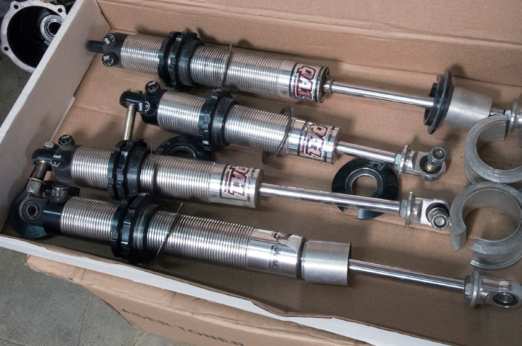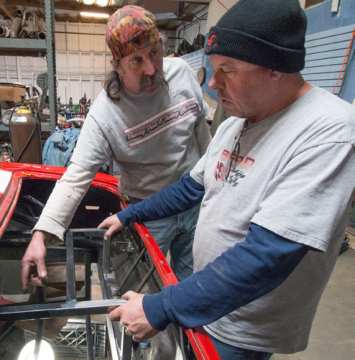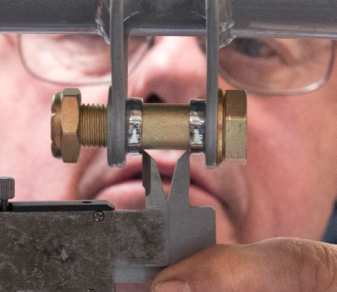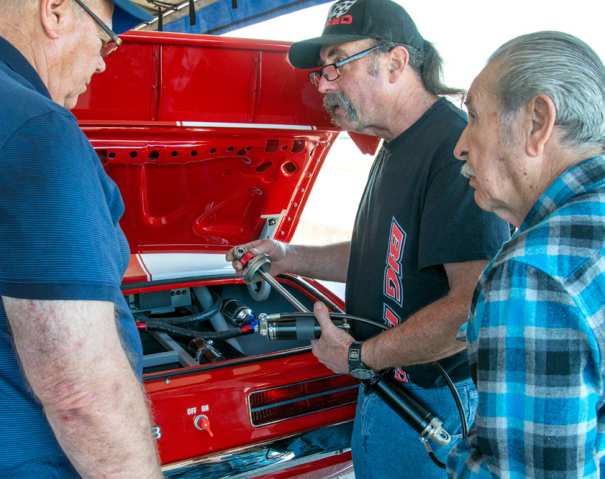Shocks / Springs

When the rebuild planning started, the crew gave their input on coil-over shocks. They’ve run QA1 Proma Star coil-over shocks since early 2012. The shocks were good, but they didn’t have great tunability. There were much better options available from QA1 and other companies. The guys felt Big Red was leaving some lap time on the table since they weren’t getting optimum performance. The decision was made to step up to Penske Racing shocks. The crew worked with the tech team at Penske to get the units that work best with the different types of racing setups and conditions. They ended up with 8700 Series Remote Mount triple adjustable shocks with better performance and more tuning. They have external reservoirs, so mounting them required the fabrication of new mounts in the engine compartment and in the trunk.
In 1987, Big Red was first built with Griggs Racing shocks, which were actually Spax racing shocks but custom built to Bruce Griggs’ specifications. The shocks were still in service until May 2011, when Big Red ran at the Texas Mile. At that time, Big Red was running the same Griggs Racing shocks that were on the car since 1987-88. That’s quite a run. They were retired in 2012, when service parts were hard to find. New QA1 Proma Star double-adjustable coil over’s got their maiden voyage on Big Red at Mojave in May 2012. The front shocks were QA1 901DD and the rears were 701DD. They were retired in 2015. Their last race was Runway Racing’s Top Speed Challenge event at Mojave (1.5-mile course). That event was legendary for the team. Big Red went 251.8 mph, a new record. Big Red’s rebuild started on November 20, 2015. That’s when they upgraded to the 8700-Series Penske Racing Shocks. The new Penske shocks have remote reservoirs, so additional mounts are required. The front reservoir mounts are added to the engine compartment cage out of the way. Mocked-up tubing gave Dave an idea of space requirements while welding the brackets in place


The new Penske shocks were held in the chassis with extra-long temporary bolts. Some of the old fasteners were adequate, but not 100-percent correct for the job. The front suspension radius rod bolts are a good example; the old bolt (in Tim’s hand) didn’t have the correct shoulder length, and it was longer than needed. The new fasteners in the radius-rod mounting tabs were the correct hardware for the job. Tim used his caliper gauge to make spacers that would align the shock body mount between the tabs. Being centered allows the shock to have full range of motion without binding. The shocks were ordered with specific lengths of remote reservoir lines. Dave and Tim discuss where the rear-shock remote reservoirs should be mounted. They settled on mounting them to the sides of the fuel tank safety cage. The hoses run forward to the rear coil-over shocks, which mount to the side of Big Red’s chassis on some old mounting tabs. The tabs had survived since 1987, but Dave didn’t like them hanging out there. He added a gusset/plate between the two tabs to keep them from moving independently. Being welded together increases their strength. The lower rear shock mount already had a gusset/plate welded between the left and right linkage mounting plates.
Since Big Red does many different types of racing, the new Penske shocks will end up wearing many different coil-over springs. Big Red’s shelf at the shop has a collection of springs rated from 250 to 800 pounds from Eibach, Hyperco, and Stock Car Products. Fully extended, the old QA1 DD901 rear shocks had an extended length of 23.625 inches long. They were 4.125-inch longer than the front QA1 shocks (19.5 inches long). The replacement Penske shocks were ordered in similar extended lengths. The Pikes Peak rear-suspension setup is easily identified with the upper third link on the top of the differential housing. This setup uses silver 275-pound Eibach springs. Just to the side of the coil-over’s top mount is a small, rectangular plate that covers the hole that feeds through the rear shock’s remote reservoir.
The Mojave rear-shock setup uses white 300-pound Stock Car Products springs. When running Land Speed, the guys install KarTek limit straps for safety. If Big Red were to spin at high speed, the car could get lift from air under the car. With the straps in place, they stop the gradual unloading of the rear suspension, which helps keep the car on the ground. The straps limit the amount of shock travel, and upsets gradual lift with a solid stopping point. The strap is added to the lower shock mount by installing a longer bolt and adding a bushing to keep the strap from binding on the shock and spring. The rear coil-over assembly was ordered with a long remote reservoir hose length. This allowed Mark to mount the reservoir in the trunk close to the back of the car on top of the fuel cell.


Pictured from left to right are a Griggs Racing shock (front shock), a QA1 double-adjustable Proma Star shock (rear), and the Penske Racing shock (rear). Tim’s long-time friend Bruce Griggs (far left) traveled to Buttonwillow Raceway to help Dave and Larry tune the new Penske shocks. All the settings and handling characteristics of different setups are recorded in the Big Red log book. The silver 275-pound Eibach springs and blue 300-pound Hyperco springs have their own applications. The more-pliable Eibach’s worked best in Colorado at Pikes Peak. The track configuration at Thunderhill were better matched with the Hypercos. After making some shock adjustments, (from left to right) Dave, Bruce, and Cliff viewed footage from an onboard camera to see what their changes affected. Dave used a KarTek Off Road nitrogen pressure tester to see how much nitrogen is inside the remote reservoir. He can bleed off the pressure when softening the shock is necessary. Then he added more notes to the log book.